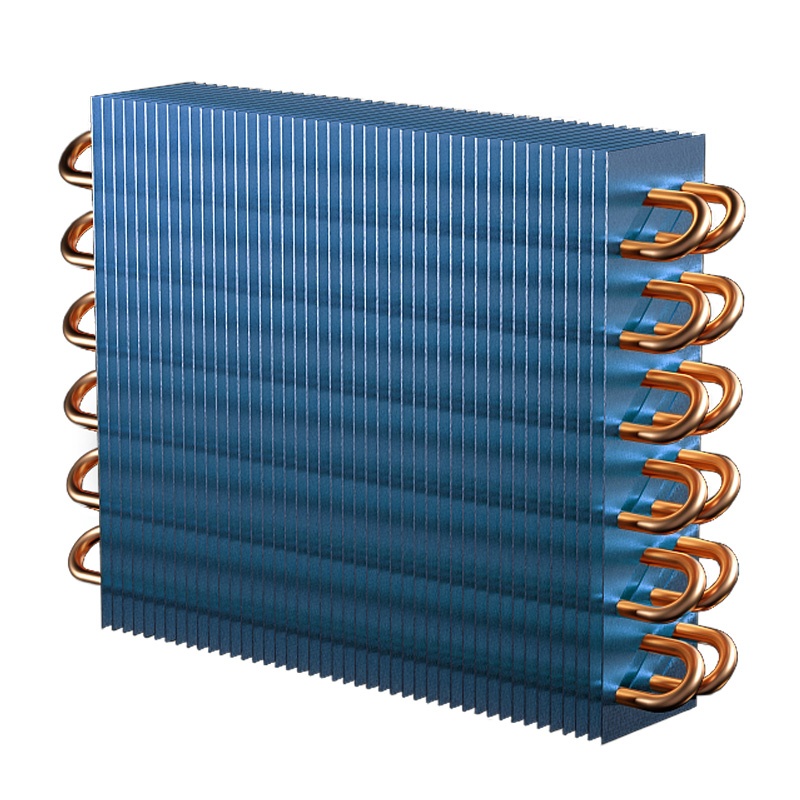Fin heat exchangers are vital components in thermal management systems, known for their ability to enhance heat transfer efficiency through the use of extended surfaces called fins. These fins increase the contact area between fluids and the exchanger surface, making them ideal for applications where one medium—often air—has low thermal conductivity. From HVAC systems and industrial refrigeration to automotive radiators and aerospace cooling units, fin heat exchangers are engineered to deliver reliable performance while optimizing space, weight, and energy consumption. This article explores the unique aspects, modern advancements, and design innovations that make fin heat exchangers a critical choice in today’s heat transfer solutions.
Purpose of Fins in Heat Exchangers
Fins are extended surfaces designed to increase the effective surface area available for heat transfer between a solid surface and a surrounding fluid. Fin heat exchangers are especially useful where one of the fluids (typically air) has low thermal conductivity—commonly seen in HVAC, refrigeration, and automotive applications.
Thermal Conductivity Optimization
- Material selection is critical for performance. Aluminum is widely used due to its high thermal conductivity, lightweight nature, and corrosion resistance. However, in corrosive or high-pressure environments, copper fins or stainless steel fins may be preferred despite higher costs.
- Some specialized systems use bimetallic fins, combining different metals to balance cost, corrosion resistance, and heat transfer.
Fin Geometry Innovations
Modern fin heat exchangers utilize a range of fin geometries:
- Louvered fins: Enhance turbulence, improving heat transfer coefficient.
- Slit fins: Introduce micro-vortices, improving performance in compact designs.
- Wavy or serpentine fins: Promote airflow mixing and delay flow separation.
- Offset strip fins: Provide high surface area density and are used in high-performance compact heat exchangers.
Each geometry is tailored based on fluid flow characteristics and required thermal duty.
Airflow & Pressure Drop Balance
One unique design challenge in fin heat exchangers is balancing thermal performance with pressure drop:
- Too dense a fin array improves heat transfer but increases resistance to airflow.
- Engineers optimize fin pitch (spacing) to avoid excessive fan energy consumption while maintaining effective cooling.
Anti-Frost Fin Designs
In low-temperature applications (e.g., evaporators in refrigeration), frost accumulation can reduce efficiency. Unique design measures include:
- Hydrophilic coated fins that prevent water droplet retention.
- V-shaped fin arrangements to allow natural drainage.
- Use of wide-fin spacing in freezers to delay frosting.
Application-Specific Customization
- Automotive Radiators: Use serpentine fin cores for lightweight and vibration-resistant designs.
- Aerospace: High-strength aluminum fin exchangers with micro-channel cores for efficient space utilization.
- HVAC Units: Often use hydrophilic-coated aluminum fins to reduce dust build-up and improve air quality.
Manufacturing Innovations
- Fins are often mechanically bonded, brazed, or expanded into the tubes.
- Vacuum brazing is increasingly used for better joint strength and leak resistance in compact heat exchangers.
- Additive manufacturing (3D printing) is now being explored to create highly customized fin geometries that were previously impossible to fabricate.
Sustainability and Material Efficiency
With increasing environmental regulations, fin heat exchangers are being designed to:
- Use recyclable materials like aluminum.
- Reduce refrigerant charge by optimizing internal volume.
- Incorporate modular fin cores for easy repair and recycling.
Fin heat exchangers represent a perfect synergy of simplicity and engineering precision. With ongoing advancements in fin geometry, materials, coatings, and manufacturing techniques, these exchangers continue to evolve—meeting the increasing demands for energy efficiency, compact design, and operational durability across industries. Whether it’s reducing frost buildup in low-temperature environments or improving heat rejection in compact spaces, fin heat exchangers remain a trusted solution for optimized thermal performance. As industries shift toward smarter and more sustainable technologies, fin heat exchangers will undoubtedly play an even greater role in the future of efficient heat transfer systems.
